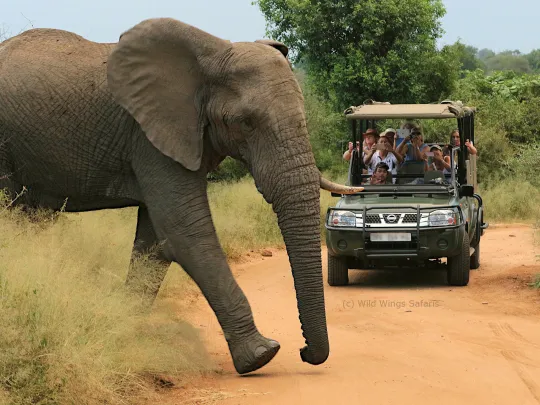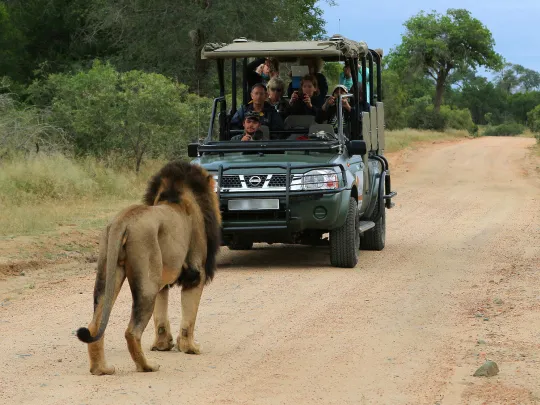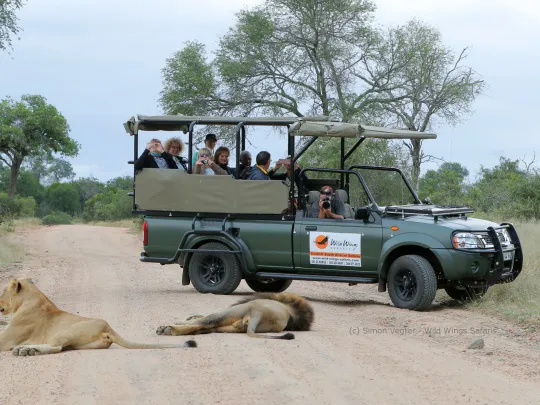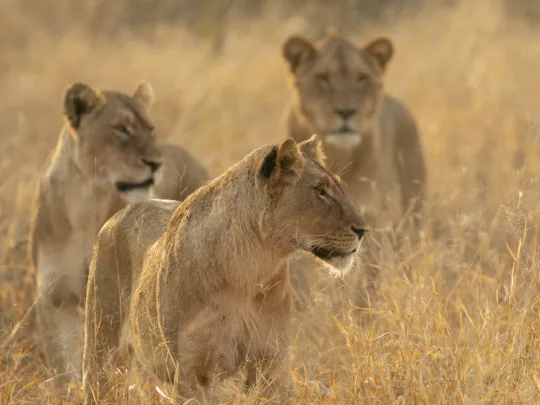Top 10 Things You Probably Didn't Know About Kruger National Park
South Africa's Kruger National Park is a beloved safari destination, attracting both international travellers and South African locals. Most people know it's one of the best national parks for game viewing—but here are 10 things you may not know about Kruger ...
1. Kruger National Park is Enormous

Kruger at sunset
Greater Kruger is one of the largest nature conservation areas in the world. The Kruger National Park alone covers nearly 20,000 km² (7,600 mi²)—about the size of Israel—and stretches across two South African provinces: Mpumalanga and Limpopo. It also borders two countries: Zimbabwe and Mozambique. When you include the adjacent private game reserves that make up Greater Kruger, the total protected area becomes almost the size of Belgium.
To truly grasp the scale of Kruger, head to the lookout point at Olifants Rest Camp around sunset. There's something profoundly humbling about standing there and realising that, in every direction—horizon to horizon—you're looking at untouched, wild African bushveld. It's a view that gives you a whole new perspective on life.
2. It's Part of the Greater Limpopo Transfrontier Park

Cheetah sighting
In 2002, the Great Limpopo Transfrontier Park (GLTP) was officially proclaimed—a groundbreaking 35,000 km² peace park that links South Africa's Kruger National Park with Mozambique's Limpopo National Park and Zimbabwe's Gonarezhou National Park. This transboundary conservation area is managed as a single ecological unit across international borders, promoting wildlife movement and cooperation between countries.
Typically, most safari-goers choose between staying inside Kruger National Park or at one of the adjacent private game reserves that form part of Greater Kruger. The two experiences are quite different—and the Kruger vs Private Reserves debate is hotly contested among safari enthusiasts on forums and social media platforms.
Why choose? A combo safari gives you the best of both worlds—the vast scale and ecosystem diversity of Kruger, combined with the exclusivity, off-road access and intimate wildlife encounters of the private reserves.
3. Kruger is One of the Oldest National Parks in Africa
Kruger was proclaimed in 1898 by President Paul Kruger to protect wildlife from overhunting. It opened to the public in 1927, charging £1 per vehicle. Just three vehicles entered that year.
The park is rich in history, with ancient San rock art, Iron Age ruins, and archaeological sites like Masorini and Thulamela that reveal early settlement patterns and cultural heritage.
4. It Has Incredible Biodiversity

Giraffe, zebra, buffalo, wildebeest and impala at a waterhole
Kruger boasts the highest variety of large mammals in any national park globally. Beyond the iconic Big 5, visitors may spot cheetahs, wild dogs, hyenas, 114 reptile species, 507 bird species, and over 336 types of trees. This diversity makes Kruger endlessly fascinating for repeat safaris.
5. It's a Truly Wild Experience
Battle at Kruger
Three species - two of the Big 5 (lion and buffalo) clash ... enter a third species - an opportunistic crocodile ... and incredible drama at Kruger National Park ensues.
There are no enclosures, no shows—just wildlife in their natural habitat. Kruger is one of the most authentic safari experiences you can have. Animal sightings are spontaneous, and sometimes dramatic—like the famous "Battle at Kruger" video, where lion, buffalo, and crocodile clash.
The guide from that viral video, Frank Watts, was part of our team here at Wild Wings Safaris.
6. Kruger Has a Subtropical Climate

Lioness in the grass
Kruger's weather is generally warm year-round. Summers (Sep–Apr) are hot and rainy; winters (May–Aug) are dry and cooler—ideal for game viewing. Here's a seasonal breakdown:
- June–August: Dry winter, excellent visibility for spotting wildlife.
- September–November: Bush turns green, birthing season, high predator activity.
- December–February: Hot, lush summer; best for birding.
- March–May: End of rains, mild temps, long grasses.
Want to know the best time to go? Check out our detailed Kruger safari calendar with seasonal highlights, travel tips, and a handy climate chart showing average temperatures and rainfall throughout the year.
We post monthly wildlife sightings on our Facebook page — including recent photos, videos, and reels from our Kruger safaris. It's a great way to get a feel for what each season looks like in real time!
7. Kruger Offers a Range of Safari Styles

Hamiltons Tented Camp
From basic campsites to luxury safari lodges, Kruger has something for everyone. SANParks operates 13 main rest camps and several satellite and bushveld camps. Inside Kruger's private concessions, you'll find exclusive safari lodges with top-tier service and comfort. Read our blog on the 7 Best Ways to Do Kruger for more ideas.
8. There Are Nine Entrance Gates to Choose From
Kruger is long and narrow—about 360 km (220 mi) north to south. Depending on where you're going, you can enter via one of these gates:
- Numbi – 410 km from Johannesburg
- Malelane – 425 km
- Phabeni – 435 km
- Crocodile Bridge – 475 km
- Paul Kruger – 465 km
- Orpen – 490 km
- Phalaborwa – 490 km
- Punda Maria – 550 km
- Parfuri – 600 km
Gate times change with the seasons, opening as early as 05:30 in summer and closing as early as 17:30 in winter. Plan ahead to avoid getting stuck outside after dark.
| Months | Open | Close |
|---|---|---|
| November - February (Summer) | 05:30 | 18:30 |
| March | 05:30 | 18:00 |
| April | 06:00 | 18:00 |
| May - July (mid-Winter) | 06:00 | 17:30 |
| August - September | 06:00 | 18:00 |
| October | 05:30 | 18:00 |
9. Kruger is Easily Accessible by Road or Air

Lilac breasted roller
Kruger is well-connected to Johannesburg and other major cities by a solid road network and several airports:
- Kruger Mpumalanga (KMIA): Best for southern Kruger (Numbi, Malelane)
- Eastgate Airport (Hoedspruit): Good for central Kruger (Orpen)
- Phalaborwa Airport: Perfect for northern camps
- Skukuza Airport: Located inside Kruger; daily flights from JHB, CPT & DUR
10. Kruger is on the Frontline of Rhino Conservation

White rhino
Poaching is a major challenge. Kruger's anti-poaching team includes 650 rangers, drones, helicopters, and a canine unit. Despite these efforts, the proximity to rural poverty-stricken areas makes rhino protection difficult.
Supporting conservation efforts and responsible tourism is essential if we want future generations to see these iconic animals in the wild.
Want to Visit Kruger?
Wild Wings Safaris has been running top-rated Kruger safaris since 2005. From affordable small group tours to high-end private lodges, we'll help you experience the magic of Kruger your way.
You may also want to look at

9 Day Cape Town and Kruger Park Safari
Explore South Africa's top two destinations in one seamless itinerary. This 9-day Cape Town and Kruger safari gives you four nights in one of the world's most beautiful cities, followed by four nights in Big Five safari country. The itinerary is flexible and can be tailored to your budget, with options ranging from affordable guesthouses to exclusive five-star lodges.

3 Day Kruger Park Safari
Our popular 3 Day Kruger Park Safari is designed for those who want a quick and affordable way to experience the incredible wildlife of the Kruger National Park in the company of an expert guide. With regular scheduled departures from Johannesburg or Nelspruit, custom departure dates and private departures can also be arranged on request. Book early to avoid disappointment!

4 Day Kruger Park Budget Safari
Our 4 Day Kruger Park Budget Safari is a cost-effective yet authentic way to experience South Africa's most famous wildlife destination. This small-group safari departs regularly from Johannesburg or Nelspruit, offering expert-guided open-vehicle game drives and comfortable en-suite accommodation inside Kruger National Park. Book early to secure your spot!

5 Day Kruger Safari & Private Lodge Combo
Choosing between a Kruger National Park safari and a private game lodge can be tough—each offers unique advantages. This 5-day Kruger safari package gives you the best of both worlds! Spend two nights inside Kruger Park, where expert-guided game drives take you through diverse habitats teeming with wildlife. Then, transfer to a private game lodge in Greater Kruger, where off-road game drives bring you closer to the action, offering intimate encounters with the Big Five and other iconic species. This customisable Kruger safari lets you experience the best of both, with flexible options to suit your travel style.

5 Day Best of Kruger Safari | Classic Big Five Adventure
Discover the ultimate Kruger National Park safari on this 5-day African safari, featuring open vehicle game drives, a guided bush walk, and an exciting night safari. Stay at two different camps in Southern Kruger Park, maximising your chances of spotting the Big Five—lion, leopard, elephant, rhino, and buffalo—as well as cheetahs, wild dogs, giraffes, zebras, and abundant birdlife. Whether you're looking for an affordable Kruger Park safari or a well-rounded Kruger Park tour, this is one of the best Kruger safari options available.

Kruger National Park Area
The Greater Kruger National Park is South Africa's premier safari destination: it's the largest wildlife conservancy in Africa, set in one of the most accessible yet unspoilt wilderness areas in South Africa. It encompasses the Kruger National Park and a number of adjoining private reserves which share unfenced boundaries with the park; including Sabi Sand, Timbavati, Klaserie and Balule Game Reserves, which are home to a wide variety of private game lodges, each with its own brand of style and luxury.

Kruger National Park vs. Sabi Sand Game Reserve – Which Safari is Best?
Which is better – a safari in the Kruger National Park or the Sabi Sand Game Reserve? What are the key differences, and which option offers the best experience? Having done both many times, I'll break down the pros and cons of each. Kruger National Park offers vast landscapes, diverse wildlife, and affordability, while Sabi Sand Game Reserve is known for luxury, exclusivity, and exceptional Big Five sightings. Let's take a closer look – and explore why a Kruger Combo Safari might be the ultimate way to experience the best of both worlds.
About the author

A 'word smith' or copywriter with over 25 years experience, love travelling, wildlife and conservation; fascinated by alternative energy, alternative building and alternative health. Consummate reader and traveller, both internationally and southern Africa. Have two remarkable daughters that continue to amaze and teach me daily. Consider myself privileged to live on the best continent on the planet.









